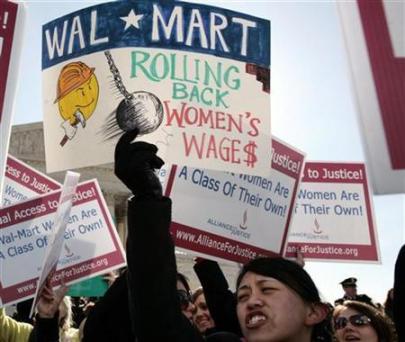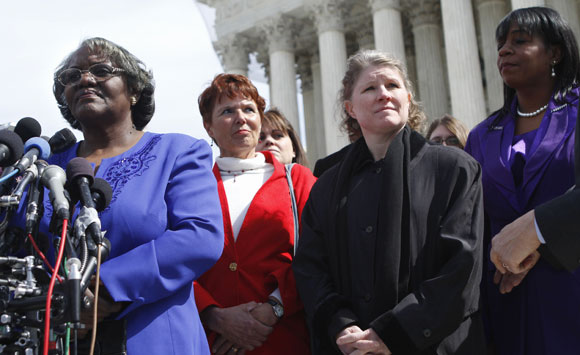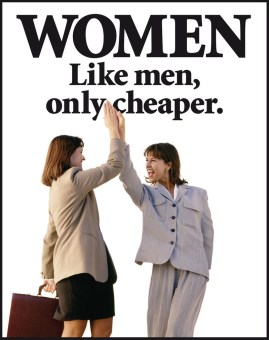Dukes v. Wal-Mart and What the Supreme Court Thinks About Oppression
In March of 2011, a class-action lawsuit was filed against giant retailer Wal-Mart, alleging that it consistently and unrepentantly discriminated against its female employees. Female employees of Wal-Mart alleged that they were paid less than male coworkers in the same or lower positions, refused promotions or refused access to information about how to get a promotion, and saw greater privileges and wages go to male coworkers who were less qualified, had fewer years on the job, and in some cases, that they themselves had trained. In their lawsuit, they called for an injunction that would force Wal-Mart to immediately cease its discriminatory practices, and also for Wal-Mart to grant them the fair wages they had been denied in back pay, the amount of which would likely come to around a billion dollars.

In June, the case went to the Supreme Court, and its momentum ground to a halt. The court ruled in favor of Wal-Mart — not because there wasn’t significant evidence to support the women’s case, there was — but because it ruled that the women of Wal-Mart didn’t constitute the “class” required for a class-action lawsuit. Among other issues relating to the technical legal definitions of a “class,” there’s a question of “commonality,” which means “questions of law or fact” common to the class. Wal-Mart is the largest private employer in the world, and women make up roughly 72% of its hourly employees. What could a group that large possibly have in commonality with one another?
The question, really, was whether the shared identity of being female was enough to mean that everyone within the “class” had been marginalized and harmed by an institution which they depended upon. And while there were other legal concerns (like the fact that the women were asking for both an injunction and a monetary reward, whereas most class action lawsuits only ask for one), the Supreme Court essentially considered this question and answered “no.”
Dayna Tortorici’s article this week in n+1 asks what it means to have the structure designed to uphold equality and justice refuse to recognize inequality, even with plentiful evidence, and places the Supreme Court’s ruling in a context of legal precedent that has either answered or ignored women’s call for equal treatment under the law, especially in the workplace. It seems that while facts of gender inequality and sex discrimination are fairly indisputable, from the wage gap to the countless documented incidents of hiring discrimination against women, there isn’t strong interest from the judicial branch in confirming that woman, and other groups, face institutionalized oppression because of their status as women. As Tortorici puts it:
“…a class of people large enough to constitute a population majority—as women did—could not feasibly be “oppressed,” or oppressed enough to require extra attention at the level of judicial review. The criterion was logical, but it couldn’t accommodate the illogical reality of patriarchy, whose influence on every aspect of daily life is so big as to be essentially invisible. It seemed as if the law could not comprehend the scope of the inequality it had confronted.”
It seems like women’s sheer numbers may be working against them as far as legal recognition of their marginalization. In that sense, maybe groups like the gay community at least has a literal minority to its name. So during the Prop 8 trial, when experts testified that gays experienced social stigma and harmful quantifiable effects of discrimination, the ruling was that Prop 8 constituted discrimination and anti-gay animus. But for subsequent rulings in higher courts, even when Prop 8 has been struck down, it’s been in ways that don’t make assertions about marriage inequality or what it means, and instead operate upon smaller, more technical aspects of the law. It would seem that higher courts aren’t as comfortable as we might like with recognizing and ruling upon the lived realities that oppression and inequality create. As the much-discussed “war on women” has demonstrated, the legislature isn’t necessarily an institution upon which women or any other marginalized group can rely to give them the protections they need, and while the fact that DOMA was declared unconstitutional and Edie Windsor recently won her case against the federal government are heartening, it seems as if it may not be wise to rely upon the courts, either.
Wal-Mart Wins Again: Supreme Court Throws Out Giant Gender Discrimination Case
The Supreme Court has ruled in favor of Wal-Mart in what was going to be the largest class action suit of all time, brought on by up to 1.5 million women against the corporation, the country’s largest employer, for discrimination.
A 5-4 vote determined that the suit could not go forward because the plaintiffs were unable to show that Wal-Mart had a common, chain-wide policy of discriminating against women.
+
+
Because individual store managers were the ones responsible for pay levels and promotions, Wal-Mart said, it wasn’t their overall fault. (It was just the individual fault of the bajillion employees who carried out sex discrimination locally in their own little area!)
This is a big “victory for Wal-Mart,” a company really in need of no additional victories, but also may help shield larger employers from similar claims in the future on anything claiming race/gender bias. From The Los Angeles Times:
Had civil rights lawyers succeeded in the case, they had hoped to bring other suits against large employers who allegedly relegate women or minorities to lower-paying jobs.
“In a company of Wal-Mart’s size and geographical scope, it is quite unbelievable that all managers would exercise their discretion in a common way without some common direction,” said Justice Antonin Scalia. Because class actions are suitable for resolving disputes that turn on a common issue, this lawsuit cannot go forward, Scalia said.
While the court’s liberals disagreed on this point, they agreed with Scalia that the class-action claim was flawed because it sought individual awards of back pay for the women. All nine justices said this class-action suit could not seek monetary damages for the women workers.
Scalia’s opinion strongly suggested that such claims cannot proceed as a single class-action suit unless the plaintiffs can point to a company policy of discriminating against certain employees.
Justice Ruth Bader Ginsburg had a partial dissent:
[Plaintiffs] allege that the company “[r]eli[es] on gender stereotypes in making employment decisions such as … promotion[s] [and] pay.” Wal-Mart permits those prejudices to infect personnel decisions, the plaintiffs contend, by leaving pay and promotions in the hands of “a nearly all male managerial workforce” using “arbitrary and subjective criteria.” Further alleged barriers to the advancement of female employees include the company’s requirement, “as a condition of promotion to management jobs, that employees be willing to relocate.” Absent instruction otherwise, there is a risk that managers will act on the familiar assumption that women, because of their services to husband and children, are less mobile than men.
Women fill 70 percent of the hourly jobs in the retailer’s stores but make up only “33 percent of management employees.” “[T]he higher one looks in the organization the lower the percentage of women.” The plaintiffs’ “largely uncontested descriptive statistics” also show that women working in the company’s stores “are paid less than men in every region” and “that the salary gap widens over time even for men and women hired into the same jobs at the same time.”
Along with Ginsburg, Sonia Sotomayor, Elena Kagan and Stephen G. Breyer did think the suit should have been allowed to proceed even if it didn’t lead to monetary values. So basically all the women thought it should go forward and the men did not. You can read more from both sides at Daily Kos.
Although this is a big win for Wal-Mart, it doesn’t take a stand on whether or not Wal-Mart is guilty of gender discrimination, only that these women can’t pursue a class-action suit together.
Daily Kos: “Bottom line: in Chief Justice Roberts’s Supreme Court, business wins again. And again.”

Plaintiffs: Betty Dukes of Pittsburgh; Deborah Gunter of Palm Springs; Christine Kwapnoski of Bay Point; and Edith Arena of Duarte. (Jacquelyn Martin, Associated Press / March 29, 2011)
Wal-Mart Stands Up Against Anti-Gay Worker But Also Is Probably Still Evil Overall
 A federal appeals court has ruled that Wal-Mart was justified in firing an employee who made anti-gay comments to a lesbian co-worker. Given Wal-Mart’s history of being the biggest assh*les of all time, this entire thing is pleasantly surprising.
A federal appeals court has ruled that Wal-Mart was justified in firing an employee who made anti-gay comments to a lesbian co-worker. Given Wal-Mart’s history of being the biggest assh*les of all time, this entire thing is pleasantly surprising.
Tanisha Matthews, an overnight stocker in an Illinois outlet, sued Wal-Mart after being fired for harassing a lesbian co-worker, identified as Amy. On a break in 2005, Matthews, who is an Apostolic Christian, got into an argument about homosexuality and religion with several co-workers. According to the ruling, Amy “reported that Matthews was ’screaming over her’ that God does not accept gays, they should not ’be on earth,’ and they will ’go to hell’ because they are not ’right in the head.’ Five other employees confirmed that Matthews had said that gays are sinners and are going to hell.”
Can we just take a moment to acknowledge that that sentence exists in the world? “Five other employees confirmed that Matthews had said that gays are sinners and are going to hell.” This is the world we live in.
Anyhow, after a three-month investigation, during which Wal-Mart collected statements from employees who had been present for the incident, Matthews was fired for violating the non-harassment and anti-discrimination policy. The policy prohibits anything that might be interpreted as harassment based on an individual’s status, specifically including sexual orientation, and says that anyone who violates the policy could be subject to discipline, including termination. (This is the policy which heaps of women in the Wal-Mart case say was not enforced in their stores.) Matthews then took Wal-Mart to court, claiming that she had been discriminated against because of her religious beliefs and in violation of the 1964 Civil Rights Act.
And she lost. Twice.
The first court ruled in Wal-Mart’s favour since there was no evidence Matthews had actually been discriminated against, and since, because she had violated the non-discrimination policy, the company was well within its rights to fire her.
Last week, the decision was upheld in appeal, because there was still no evidence. Even if Matthews’ religion or her personal ideas about it support screaming about lesbians and hellfire at work, and the court ruled that the incident of harassment was still key and that “and employers need not relieve workers from complying with neutral workplace rules as a religious accommodation if it would create an undue hardship.”
According to the Chicago Sun-Times:
“In her suit, Matthews claimed Wal-Mart engaged in religious discrimination by firing her for expressing religious beliefs. “But if Matthews is arguing that Wal-Mart must permit her to admonish gays at work to accommodate her religion, the claim fails,” the Appeals Court stated in its decision.
Wal-Mart “fired her because she violated company policy when she harassed a coworker, not because of her beliefs,” the ruling states.
The decision stated that, “in any event, Wal-Mart’s anti-harassment policy establishes that her conduct qualified as harassment and that Wal-Mart may fire rather than merely suspend her.”
It would be really, really great if this entire incident could be read as Wal-Mart suddenly growing a sense of ethical and social responsibility and standing up for gay rights, but it shouldn’t be. It’s worth mentioning, however, that there are billions of Wal-Mart stores out there, and a lot of them are run by jerks and this one is run by a nice person. These things vary from store to store.
Target and Wal-Mart keep playing with our hearts, right? Like pick a side already, ideally our side. It’s fantastic that this particular part of the chain’s anti-harassment policy was put to the test and that someone was fired for making anti-gay comments, because that probably doesn’t happen as frequently as it should.
The chain still has a record of denying benefits to same-sex partners, ignoring discrimination based on gender identity, and an unfortunate history of policies that “provide little to no protections for, and at times even hostility toward, their L.G.B.T. employees.” And then there’s that gender discrimination class action lawsuit (and p.s., go read that article right now). Which all still shows that even though it (very rarely) sometimes does the right thing, Wal-Mart is still completely, utterly evil.
At Last, the Sex Discrimination Lawsuit Against Wal-Mart Has Come Along
 Tomorrow, the Supreme Court of the United States will conduct a “limited review” of the Ninth Circuit’s order upholding class certification in what will be (if all goes well tomorrow) the biggest f-cking class action lawsuit of all time: Dukes v. Wal-Mart. From The Impact Fund:
Tomorrow, the Supreme Court of the United States will conduct a “limited review” of the Ninth Circuit’s order upholding class certification in what will be (if all goes well tomorrow) the biggest f-cking class action lawsuit of all time: Dukes v. Wal-Mart. From The Impact Fund:
Four lower court rulings over the past ten years of litigation have agreed that plaintiffs have presented significant evidence of company-wide pay and promotion discrimination, that Wal-Mart has lagged far behind its competitors in its promotion of women, and that Wal-Mart has failed to address gender discrimination against its female employees despite being well aware of its prevalence.
If the Supreme Court sides with the defendants, aka Wal-Mart, it could bring “a virtual end to employment discrimination class actions filed under Title VII of the Civil Rights Act of 1964.” So it’s kinda important that we win this thing.
+
Do the Women of Wal-Mart Constitute a Class?

some of the women suing wal-mart
Well, firstly — you might be wondering — what is a class action lawsuit? It’s basically when heaps of plantiffs, all making basically the same claim, collectively bring their claim to court or file a lawsuit. This particular lawsuit was initially filed in June 2001 by six current/former Wal-Mart/Sam’s Club employees, including some who alleged female employees were discriminated against when making decisions about making promotions, job assignments, training opportunities and pay decisions:
Generally stated, plaintiffs allege that women employed in WalMart stores (1) are paid less than men in comparable positions, despite having higher performance ratings and greater seniority; and (2) receive fewer promotions to in-store management positions than do men, and those who are promoted must wait longer than their male counterparts to advance.
Wal-Mart has spent the last ten years staving off this lawsuit by arguing that these million or so women represented by the six do not constitute a “class.”
In other words — Wal-Mart’s not saying these allegations aren’t true, they’re just saying it’s not really fair to lump all these cases together because “the numbers alone make this case impossible.”:
Plaintiffs’ entire case is premised on the discretion afforded individual managers to make pay and promotion decisions, yet they concede that this “subjectivity” is exercised within a company-wide framework of objective standards that prohibit discrimination and require equal employment opportunities. Discriminatory decisions made by individual managers within such an objectively nondiscriminatory system are, by definition, aberrational and unauthorized rather than “common” or “typical.”
In 2004, Judge Martin J. Jenkins of the district court sided with the plantiffs, and subsequently the Ninth Circuit (that’s right, our favorite Judge Vaughn Walker) also sided with the women of Wal-Mart. So now Wal-Mart is taking this ish to the Supreme Court, which The New York Times says is a good idea for Wal-Mart:
It is probably a smart legal move, given the court’s clear tendency to rule in favor of corporations, particularly when big classes or discrimination claims are involved. We hope the court resists the temptation to toss out the case, which would force women to file lawsuits one by one. Wal-Mart’s employment practices deserve a full hearing.
+
Who is a Part of this “Class”?

In 2004, the Court declared “all women who worked at Wal-Mart retail stores in the U.S at any time since December 26, 1998” a member of the “class.” Jenkins found that statistics on Wal-Mart, the largest private employer in the world, showed female Wal-Mart workers were paid less than men in every region and most job categories with a salary gap widening over time.
If you’re a woman who works at Wal-Mart, then, you’re a part of this class being represented by these six women. If we win, lady Wal-Mart employees will have a chance to exclude themselves from the class and later, if they choose to be included, will have a chance to file a claim to share in the settlement.
The payout would be in the neighborhood of a billion dollars — which honestly isn’t much when you consider that Wal-Mart makes $405 billion in annual sales and operates more than 8,400 stores.
The Waltons personal assets qualify as the richest private wealth accumulation ever in the whole world, running over $8 billion dollars. Wal-Mart is considered one of the most profitable companies in America. The average yearly earnings for a Wal-Mart employee is $13,861. The cost of the Waltons’ Jet fleet totals over $125,350,000.
The Evidence
The evidence used in the case will include statistics as well as the testimonies of these 115 unique declarants. I’ve read like 50 of them with my mouth agape. You must read a few or at least read summaries of some of the cases here.
These women report dozens of instances each of being passed over for promotions or otherwise hoodwinked out of positions they’d expressed interest in and were qualified for. There’s little things too; like men getting requested time off or store transfers while women were denied those same requests. Some women report working 60 hours a week without overtime and still making less than their male counterparts. Eventually many of these women realize that it’s just never going to happen, and they leave Wal-Mart, many of these women get fired for speaking up, and many stay at Wal-Mart because they don’t have any other options.
Each singular incident of gender discrimination — and each brief contains at least 10 or 30 — of gender discrimination — would be enough to make a woman want to quit her job and enough to send a Smith College Women’s Studies undergrad into epileptic fits. Women moved their families around the country in a wild goose chase. Women devoted 20 or 30 years to a company that basically cockblocked them at every turn. It’s like the Biggest Cockblock of All Time.
Even more shocking are the reports of sexual harassment in these reports which, when reported, were categorically dismissed, ignored, or, often ridiculed.
+ [District Manager Salby] was very abusive in his language, and called me a “worthless broad.”
+ [Mr. Miller] forced his hand down the front of my shirt and grabbed my left breast. I was 17 years old at the time.
+ The district manager would sometimes hold the lunch meeting at Hooter’s restaurant… during the meeting, I was forced to listen to lots of discussion among the male managers about the waitresses’ breasts and butts and which sexual experiences they would like to have with them… I knew from attending the annual company meetings that the male managers often went out together to strip clubs after the meeting. It seemed to me to be an accepted part of the culture.
+ Support Manager Gilbert Hill, my direct supervisor, repeatedly harassed me with comments and questions such as, “when are we going to have sex?”
+ [Co-Manager Ryan] would, frequently, touch me including brushing up against me, touching my butt and massaging my shoulders… at one point he asked that I join him in his hotel room… he pushed me against some pallets and put his hands up the front of my shirt.
+ [Produce Manager Donnie Gateley] was constantly saying things to me like, “Can’t you wear lower cut shirts?” “You have a nice ass.” “Women are put on this earth for one thing. My wife isn’t any good at it. Are you?”
When the lawsuit was filed in 2001, women occupied 14 percent of store manager positions and more than 80 percent of lower-ranking supervisory jobs with hourly raises.
Average Hourly Rates
4 Largest Hourly Jobs, 2001
| Total | % |
Average $/Hour | ||
|---|---|---|---|---|
| Job | EEs | Women | Men | Women |
| 000101 DEPT HEAD | 63010 | 78.5 | 11.13 | 10.62 |
| 000201 SALES ASSOC | 96539 | 68.1 | 8.73 | 8.27 |
| 000469 HD/HM O/N | 28408 | 57.8 | 9.56 | 9.29 |
| 000501 CASHIER | 49261 | 92.6 | 8.33 | 8.05 |
| Total All Hourly | 463526 | 70.6 | 9.55 | 9.26 |
Following the 2001 lawsuit filing, the company made a few changes — for example all open positions are now posted electronically, preventing the men in charge from keeping women out of the loop altogether. Directly after the suit was filed, it’s reported that many women were immediately promoted, though subsequent pay raises never came.
In my non-expert opinion, it seems like in many Wal-Mart stores, management is just a Boy’s Club. The men want to keep their culture of lunch meetings at Hooters, misogynistic jokes and field trips to strip clubs and they do this by locking women out of the Club.
+
Wal-Mart Has a Proven Track Record of Being an Asshole:
 Is this new for Wal-Mart? Hardly. Here’s just one of many lawsuits filed against Wal-Mart, this one from 2007:
Is this new for Wal-Mart? Hardly. Here’s just one of many lawsuits filed against Wal-Mart, this one from 2007:
The United States Labor Department announced yesterday that Wal-Mart Stores had agreed to pay $33.5 million in back wages plus interest to settle a federal lawsuit that accused the company of violating overtime laws involving 86,680 workers.
Department officials said many of the violations involved failing to pay time-and-a-half premium pay to managers in training, programmers in training and some other salaried, nonmanagerial employees when they worked more than 40 hours a week.
The department also accused Wal-Mart of violating the Fair Labor Standards Act, the federal law that governs overtime, by failing to properly include factors like bonuses and geographical differentials in calculating the base wages to determine the time-and-a-half rate.
A lot of communities, then, have successfully rallied to keep Wal-Mart out of their city. In New York, the Gay and Lesbian Task Force got involved, too:
The task force criticized Wal-Mart for denying employee benefits to same-sex partners and for failing to prohibit discrimination based on gender identity. By comparison, the group said two other chain stores with a strong presence in New York, Costco and Walgreens, did much better.

You can (and should) read the heaps of evidence against Wal-Mart on this website. These offenses include driving down wages in urban areas, costing the taxpayers millions in Medicaid given to uninsured Wal-Mart employees, using illegal surveillance techniques to monitor union activity while refusing to monitor its parking lots, which have become hotspots of violent crime, exploiting its workers abroad, using illegal immigrant labor, destroying small businesses, abusing the environment and violating Clean Water Act policies.
Have you seen Wal-Mart: The High Cost of Low Prices? If not, you must. This section discusses some of the gender and racial discrimination that happened at Wal-Mart:
There’s a rally tomorrow in support of the Women of Wal-Mart, and you should go. You can read more about the case here.
Riese’s Team Pick: Wal-Mart – The High Cost of Low Prices
As you know, we love documentaries!
I saw this documentary, Wal-Mart: The High Cost of Low Prices yesterday and I’d been putting off watching it ’cause corporate world takeover is one of my top three concerns and I knew it would freak me out and IT TOTALLY DID AND YOU HAVE TO WATCH IT. Maybe you already have it came out like a while ago. Seriously I have thought of little else besides Wal-Mart for at least 24 hours. Thank G-d I was on my deathbed yesterday and forced to participate in passive activities like watching films.
I wouldn’t lie to you, this is a thing you need to know about. I recommend it as a double-feature America the Purchased Night with Casino Jack: The United States of Money, which Brandy & Julie watched and did a thing for but then we decided not to use it but we are using a lot of it in the upcoming Behind-the-Scenes Retrospective that will delight you to the very very core of your special special self.
I saw it on Netflix but you can also “rent” it via amazon for $2.99: Wal-Mart: The High Cost of Low Price, also visit the website. You could also look it up on YouTube if you can’t afford to rent it or buy it from their website or see it on Netflix or iTunes, it’s all on there. But if you can afford it, it’s always good to toss these people some money,
I feel like this trailer doesn’t even begin to scrape against the monumental importance of this thing.